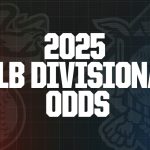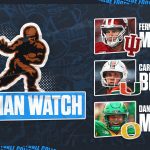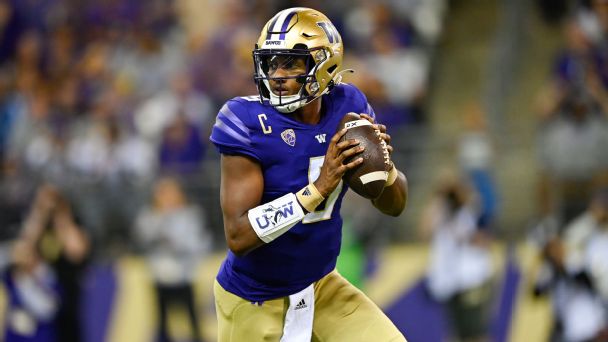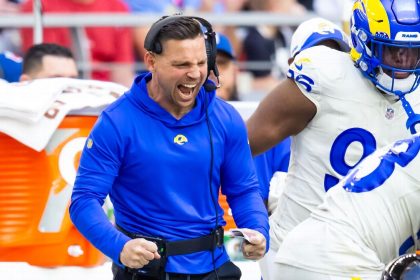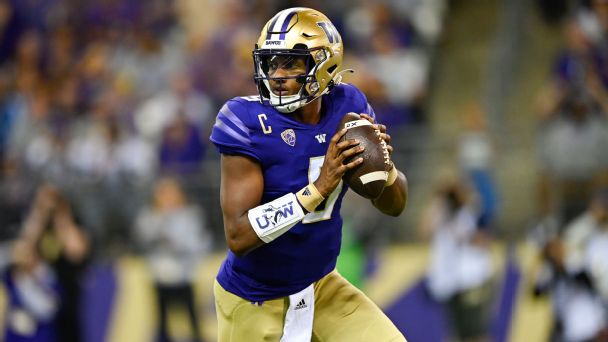
The headlines didn’t match the product last year out West. A sky-is-falling vibe was unavoidable following the announcement that USC and UCLA would be joining the Big Ten in 2024, leaving the Pac-12 unmoored and scrambling. But just as the Big 12 did in 2021 following its own announced departures (of Oklahoma and Texas), the conference put on a show.
Six Pac-12 teams won at least nine games and finished 22nd or better in SP+, and several first-year coaches, from USC‘s Lincoln Riley to Washington‘s Kalen DeBoer, obliterated expectations. USC’s dismal defense prevented it from becoming the league’s first College Football Playoff team since 2016, but this was an utterly delightful conference to watch.
That should be the case again in 2023. The headlines aren’t particularly happy now either, but the product should please the eye.
USC, Oregon, Washington and two-time defending champ Utah all enter the season as contenders, with UCLA and Oregon State potentially not far off the pace. I can’t decide who I like the most — I talked myself into both USC and Utah at some point while writing last week’s preview of the former South division teams, and I’m very much talking myself into both Oregon and Washington now — but that’s pretty exciting in itself. So is the fact that the scoreboard operators will be busy. The top five projected offenses in this conference, per SP+, rank first, fourth, eighth, 12th and 13th in the country with three others in the top 50. (The top defense is projected 26th.) The West has rarely lacked entertaining ball, and it certainly won’t this fall.
The future is uncertain (again), but damned if the present isn’t thrilling (again). Let’s preview the former Pac-12 North!
Every week through the offseason, Bill Connelly will preview another division from the Group of 5 and Power 5 exclusively for ESPN+, ultimately including all 133 FBS teams. The previews will include 2022 breakdowns, 2023 previews and burning questions for each team.
Earlier previews: Conference USA, part 1 | Conference USA, part 2 | MAC East | MAC West | MWC Mountain | MWC West | Sun Belt West | Sun Belt East | AAC, part 1 | AAC, part 2 | Independents | ACC, part 1 | ACC, part 2 | Pac-12, part 1

2022 recap
If some Pac-12 teams overachieve in 2023 the way they did in 2022, someone will make a top-five run. Among the North teams, California performed almost exactly to expectation, but Oregon, Washington, Oregon State and Washington State exceeded SP+ projections by an average of 29.3 spots.
Wazzu eked out a bowl bid, while the other three went a combined 3-3 against one another and 28-5 against everyone else. Washington and Oregon tied for second with Utah in the division-less Pac-12 standings. Washington finished eighth in the final AP poll, Oregon 15th, and a walloping of Florida in the Las Vegas Bowl pushed Oregon State up to 17th.
Stanford completed its multiyear collapse and undid some of those good vibes, but this was a strong half-dozen teams.
2023 projections
Teams in today’s preview are in bold.
There’s not a lot of major movement projected here. Stanford should still be bad, Oregon and Washington should still be top 15ish, and Washington State and Cal should both be scraping and clawing for a bowl bid. Oregon State could be the primary wild card, for reasons we’ll discuss below.
Burning questions
Oregon and Washington are basically the same (super exciting) team. Which one is better? We obviously don’t know what the future Pac-12 will look like, but in quite a few of the many alternatives, perceptions of the conference will depend on Oregon and Washington playing at or near their capabilities at all times. The past year has shown us what that might look like.
In Dan Lanning’s first season replacing Mario Cristobal at Oregon, he won the same number of games as Cristobal did in 2021 with a definitively better product. The Ducks’ offense went from good to outstanding, and the defense went from bad to decent. Oregon went 1-3 against SP+ top-20 teams, losing two of three tossups and getting pummeled by Georgia (there’s little shame in that). But it went 9-0 against everyone else and took down North Carolina in a fun Holiday Bowl to finish at 10 wins.
Meanwhile, in his first season as Washington’s head coach, Kalen DeBoer did what he has done at pretty much every other football job he has had, from Sioux Falls head coach to Indiana offensive coordinator: kick butt. The Huskies jumped from 4-8 and 84th in SP+ to 11-2 and 15th, losing back-to-back road games early in the season but otherwise running the table.
Both teams featured transformative transfer quarterbacks. Michael Penix Jr. came to Washington from Indiana to rejoin DeBoer and completely turned his career around. He spent 2021 at far less than 100% after a knee injury late in 2020, but he was rejuvenated last season, throwing for 4,641 yards and 31 touchdowns. Washington’s schedule didn’t feature much in the way of strong pass rushes, which certainly helped the offensive line’s protection numbers, but the Huskies went 3-0 against SP+ top-20 teams and averaged a solid 29.3 points per game against them.
At Oregon, Bo Nix found a gear we didn’t necessarily know he had as a three-year starter at Auburn. He averaged 2,417 passing yards, 13 TDs and a 59% completion rate on the Plains; he produced 3,593 yards, 29 TDs and a 72% completion rate in Eugene and added 510 non-sack rushing yards and beautiful scrambling as well. While he frequently went into “It’s Bo Nix time!” hero mode at Auburn, with spectacularly hit-and-miss results, he suffered minimal disasters last year, taking just five sacks and throwing seven interceptions. Big plays were hit and miss in Kenny Dillingham’s offense, but Oregon was mercilessly efficient, ranking first in rushing success rate and second in passing success rate. Nix finished eighth overall in Total QBR. (Penix was 13th.)
Nix and a junior-heavy skill corps — backs Bucky Irving and Noah Whittington (2,305 combined rushing and receiving yards), receivers Troy Franklin and Kris Hutson (1,363 combined receiving yards and nine scores) and transfer receivers Tez Johnson (Troy) and Gary Bryant Jr. (USC) — should do serious damage. But Dillingham is now Arizona State’s head coach, and four strong offensive linemen are gone. Can new coordinator Will Stein (formerly of UTSA) and a mix of transfers and former backups keep Oregon’s offense near the top of the charts?
If there’s any regression on offense, the Ducks’ defense should be able to offset it. Twelve of the 18 players who saw 200-plus snaps last year return, and Lanning added starters from South Carolina (DE Jordan Burch), Iowa (LB Jestin Jacobs), Colorado (CB Nikko Reed), Ole Miss (nickel Tysheem Johnson) and Fresno State (safety Evan Williams), plus 11 blue-chip freshmen. Coordinator Tosh Lupoi has a lot to work with, though he had enough pieces to expect something better than a No. 60 defensive SP+ ranking last year, too.
It’s a similar story in Seattle. The Huskies’ offense was awesome and should be again. Penix and his five leading receivers return, led by a pair of 1,000-yard stars in Jalen McMillan and Rome Odunze. Leading rusher Wayne Taulapapa and three interior linemen are gone, but this was a pass-first, pass-second offense, and with Penix, this receiving corps and two potential all-conference tackles (junior Troy Fautanu and sophomore Roger Rosengarten) back, Washington should have what it needs.
Defensively, we’ll see. The Huskies prevented big plays reasonably well, but they weren’t aggressive at all, finishing 98th in success rate allowed, 115th in turnover rate and 109th in havoc rate (TFLs, passes defended and forced fumbles divided by total plays). They have potentially the deepest set of defensive tackles in the conference, led by Faatui Tuitele and Tuli Letuligasenoa, and edge rusher Bralen Trice is a force. But they had those guys last year and still stunk against the run.
Can new additions such as corner Jabbar Muhammad (Oklahoma State) and linebacker Ralen Goforth (USC) give the Huskies enough juice to jump back to a top-30 level? If so, Washington could be the conference favorite. Unless Oregon is. Or USC. Or Utah. Don’t make me decide.
Can Oregon State’s offense rebound more than its defense regresses? You can see whatever you want in Oregon State in 2023.
Positive spin: Jonathan Smith’s Beavers broke through with their first 10-win season in 16 years last fall, and they did so with their worst offense in years. They averaged an offensive SP+ ranking of 36th from 2019 to 2021, and while quarterback injury issues led to a slide there, the defense suddenly figured everything out and leaped from 89th to 16th in defensive SP+. Now they’ve got Clemson transfer and former blue-chipper DJ Uiagalelei taking over behind center, and he should engineer an offensive rebound. Good offense plus last year’s defense equals a potential top-15 team, right?
Negative spin: Uiagalelei didn’t exactly light the world afire at Clemson — hence his decision to transfer — so he’s not an automatic upgrade. He finished 97th in Total QBR in 2021 and improved only to 52nd last fall. Meanwhile, the defense lost breakthrough stars in linebackers Omar Speights and Kyrei Fisher-Morris, safety Jaydon Grant and corners Alex Austin and Rejzohn Wright. They were keys to last year’s surge, and without them the Beavers might revert to previous form. (Their average defensive SP+ ranking in Smith’s first four seasons: 105.3.) Was 2022 a flash in the pan?
Here’s where I very predictably say the truth is probably somewhere in the middle. Per SP+, Oregon State has improved in four of Smith’s five seasons in Corvallis. It’s hard to assume that will happen again considering the height of last year’s highs, but it suggests a pretty soft landing if nothing else. If Uiagalelei is able to play at even a top-40 level, then combined with an exciting skill corps (running back Damien Martinez is a star, and receivers Anthony Gould and Silas Bolden could thrive with a better passer) and almost all of last year’s offensive line, that should lead to something good. The run game was good enough that OSU fell to only 47th in offensive SP+ despite the quarterback issues. Uiagalelei doesn’t have to be elite for the Beavers to score a lot of points.
It’s hard to be optimistic about the Beavers fielding another top-20 defense with those losses, but the defensive line, led by tackle James Rawls, is solid. Things don’t have to completely fall apart there, especially if Wyoming transfer Oluwaseyi Omotosho is able to add some pass-rushing spice up front.
OSU is likely a step back from the conference’s top four, but the schedule presents a massive opportunity. The nonconference slate is manageable, and the Beavers both avoid USC in conference play and get Utah, UCLA and Washington at home. They’re underdogs in only two of their first 11 games, and slight ones at that.
Does Washington State have the athletes? The theme was similar for both Washington State and Oregon State: surprisingly good defense combined with surprisingly shaky offense. Wazzu’s high points weren’t as high, though; it played five SP+ top-20 opponents and went 0-5 with two close losses and three by double digits. Defense was a relative strength, but the Cougars allowed 34 points per game and 7.0 yards per play against those top-20 teams. The offense had its moments but averaged just 12.5 points per game against top-40 defenses. WSU seemed like a well-coached team that could hold its own as long as it didn’t have a major disadvantage in physical skills. But the Cougars had no way to counter such a thing.
There has been just enough turnover to bring doubt to another potential top-50 finish. Last year’s best defensive tackle, two best linebackers and best nickelback are all gone, along with two 50-catch receivers and a good left tackle. There were some graduates in there, but transfers were an issue, too. Plus, offensive coordinator Eric Morris (North Texas head coach) and defensive coordinator Brian Ward (Arizona State DC) both left.
Wazzu is a particularly tricky job at the moment. Granted, it always has been, but the Cougs seem particularly vulnerable to getting their best players (and, apparently, assistant coaches) plucked away and ending up feeling like they don’t ever have quite the experience they need. Coach Jake Dickert avoided heavy use of the transfer portal himself — though receivers Josh Kelly (Fresno State) and Kyle Williams (UNLV) are intriguing additions — and we’ll see if the culture he wants to build in Pullman takes hold. But in terms of pure recruiting rankings, this looks like a solid Mountain West roster, not one built to take down Pac-12 heavyweights. And if holding your own against particularly high-level talent is a problem, then the presence of five projected top-30 opponents on the schedule is daunting. There’s minimal margin for error in the path for another bowl bid.
If Wazzu indeed overachieves, though, it’s likely because of the marriage of quarterback Cameron Ward and new coordinator Ben Arbuckle. Ward arrived in Pullman from Incarnate Word last season and threw for a solid 3,231 yards and 23 touchdowns, but he averaged just 10.1 yards per completion, and Morris’ quick passing offense couldn’t prevent him from taking a whopping 46 sacks. Ward is a born playmaker, but he tried to make things happen purely with speed and agility far too much last year. Arbuckle was the co-pilot of last year’s Western Kentucky offense, from which Division II transfer Austin Reed threw for 4,744 yards with only 11 sacks. Arbuckle was a high school assistant just three years ago and has risen rapidly; if he can coax out more big plays with fewer negative plays, Ward’s raw upside alone could raise Wazzu’s ceiling significantly.
Has Justin Wilcox solved the “portal usage at a nerd school” equation? Vanderbilt has brought in three transfers. Northwestern, too. Stanford has taken in four, Rice five. Duke took six, but three were of the small-school variety. Tulane squeezed in seven, but hey, Willie Fritz is a bit of a wizard.
Plenty of schools are living the transfer portal lifestyle at the moment, and it can completely change the speed with which coaches can refresh a stale roster. But it’s pretty tricky for teams with particularly high admission standards.
Or is it? Cal certainly qualifies for the “nerd school” moniker — and as a nerd myself, I use the term with admiration — and the Golden Bears definitely needed a refresh after going just 10-18 over the past three seasons and losing a few of their best players to the portal. Seventh-year coach Justin Wilcox earned positive headlines with bowl seasons in 2018 and 2019 and was supposedly a serious candidate for the Oregon job last year, but he needed a clear pick-me-up in Berkeley.
He might have gotten it. Wilcox brought in seven former blue-chippers via transfer, plus exciting Mountain West defenders in safety Patrick McMorris (San Diego State) and corner Nohl Williams (UNLV). While some of the 19 transfers have solid track records — former Montana State running back Isaiah Ifanse was a stick of dynamite during the Bobcats’ FCS title game run in 2021 — a lot are younger, higher-upside players who have time to develop at Cal. Combined with returning playmakers like running back Jaydn Ott, receiver Jeremiah Hunter and outside linebackers Myles Jernigan and Xavier Carlton, plus some solid beef up front, it’s possible to look at the Cal two-deep and see potential that hasn’t existed in a few years. And for whatever potential exists, most of it will return in 2024.
That last part is key because 2023’s schedule is a bear. Cal has four road games against projected top-25 opponents, plus visits from Auburn, Oregon State and USC. The Golden Bears are favored in five games, but they’ll have to win all five and pull at least one solid upset to bowl. That might be a tall ask. Still, I’m far more optimistic about Wilcox’s future than I was when last season ended. If the new pieces stick, and new offensive coordinator Jake Spavital can click with one of two sophomore transfers at quarterback — Ben Finley (NC State) or Sam Jackson V (TCU) — then we might witness the start of a mid-tenure turnaround this fall.
Does Troy Taylor have anything to work with at Stanford? David Shaw was one of the most genuinely good dudes in the college coaching profession. He was generous with his time in interviews, and my goodness, do you remember the story about him and his brother? Amazing. It was easy to hope he would continue coaching at Stanford — and continue serving as an example of how coaches could be as humans — forever. Unfortunately, his coaching itself couldn’t keep up with the times.
After succeeding Jim Harbaugh and ripping off an incredible run of success — Shaw won 82 games with an average SP+ ranking of 15.6, three AP top-10 finishes and a near-appearance in the CFP from 2011 to 2018 — results collapsed almost overnight. The Cardinal went just 14-18 from 2019 to ’22. Average SP+ ranking: 87.0. The offense wobbled between mediocre and bad, and the defense collapsed. Recruiting remained pretty solid, but Shaw lost far more transfers than he could bring in, and the tactics themselves just never got the refresh they needed.
Troy Taylor has the tactics, especially on offense. The former Eastern Washington and Utah offensive coordinator brought Sacramento State to three FCS playoffs in three years and went 12-1 last season with a delightfully creative, run-heavy, multi-QB approach. One quarterback threw for 2,417 yards as the primary passer; the other threw for 873 and rushed for 937 as something like a wildcat-plus. The Hornets were one of my favorite teams to watch, even if the defense left something to be desired at times. (They allowed 97 points in two playoff games.) They were so fun that I’ll forgive Taylor for deciding to serve as his own offensive coordinator at Stanford, a move I usually hate.
Even with strong tactics and Shaw’s recruiting, though, it’s hard to make a case that Taylor will have enough. The Cardinal’s leading returning passer threw for 65 yards last year, and their leading returning rusher averaged 3.9 yards per carry. No primary member of the receiving corps averaged more than 7 yards per target, and oh yeah, six of the eight offensive linemen with at least one 2022 start are gone. So are five of seven linebackers and seven of eight defensive backs. With minimal portal help, this seems like an extreme Year 0 situation. Taylor is starting from scratch.
SP+ favors Stanford at Hawai’i in Week 1 … and that’s it. There are some early-season tossups (including one against Sacramento State), but this could be a rough year. Taylor will need time.
My 10 favorite players
QB Michael Penix Jr., Washington. Penix suffered three straight season-ending injuries and looked like a shadow of his former self in 2021. His resurrection as an elite quarterback last fall was one of the coolest stories in college football. And now we get one more year of him!
QB Bo Nix, Oregon. I admit I was not impressed with Nix at Auburn, and I thought his winning the starting job in 2022 would hold the Ducks back. It did not. Instead, he was one of my favorite quarterbacks to watch, and he enters 2023 as a sleeper Heisman candidate.
RB Bucky Irving, Oregon. Here’s a complete list of 2022 backs with (A) at least 150 rushes, (B) an average of at least 6.5 yards per carry and (C) at least 30 receptions: Irving and UCLA’s Zach Charbonnet. That’s it.
Slot WR Anthony Gould, Oregon State. With three different quarterbacks throwing passes (and none doing it incredibly well), Gould still averaged 10.2 yards per target and 2.5 yards per route run out of the slot. If Uiagalelei is indeed an upgrade (and he probably is), Gould’s numbers could explode.
RG Levi Rogers, Stanford. The Stanford line was once loaded with former blue-chippers, and Rogers, a junior from Woodinville, Washington, is damn near the only one left. But he’s a keeper, especially in run blocking (0.8% blown run block rate).
DT Tuli Letuligasenoa, Washington. The whole was less than the sum of parts for the Huskies’ defense last season, but don’t blame Letuligasenoa, a 300-pound tackle who easily led his team with 16 run stops in 2022.
DE Brennan Jackson, Washington State. Only nine power-conference defenders managed to combine at least 15 run stops with at least six sacks, a list that included All-Americans such as Bama’s Will Anderson Jr. Jackson was on that list. He’s dynamite.
DT James Rawls, Oregon State. Rawls is listed as just a 280-pound down lineman, but he’s an absolute brawler in the trenches. He made 11 run stops and 9.5 TFLs last year and took part in at least one TFL in each of his last seven games.
CB Chau Smith-Wade, Washington State. An unheralded recruit from Chicago, Smith-Wade chose Wazzu over Wyoming … and became one of the Pac-12’s best corners by his sophomore year. He picked off two passes, broke up nine and allowed a paltry 12.4 QBR as primary coverage guy in 2022.
S Craig Woodson, Cal. The 210-pound junior is everything you want in a safety: strong and sound enough to play near the line of scrimmage (six run stops, 26% pressure rate on 27 pass rushes) and a ballhawk in coverage (two INTs, six breakups).
Anniversaries
In 1993, 30 years ago, the post-Don James era began at Washington. Every school has its what-ifs, but Washington has a really big one. Don James had already been a successful coach for two decades before he hit an incredible stride in the early 1990s. The Huskies reached three straight Rose Bowls from 1990 to ’92, and his 1991 team won a share of the national title (and was one of the best teams of the decade).
They spent more than a month at No. 1 in 1992, too, and looked poised for a repeat. But allegations of improper benefits hit in November — starting quarterback Billy Joe Hobert was heavily involved — and the Huskies lost three of four to finish the season. While the NCAA did not find any serious violations, the Pac-10 put Washington on probation in August 1993. James resigned in protest, immediately ending an 18-year, 150-win tenure. Jim Lambright held the fort, averaging 7.3 wins over six years, but the downgrade was clear.
In 2003, 20 years ago, Washington State ripped off its third straight top-10 finish. The Wazzu job will always be a tricky one, but Mike Price had it all figured out for a minute. He engineered three top-10 finishes in six seasons (1997, 2001, 2002), and when he left to (briefly) take the Alabama job, successor Bill Doba rode a nasty defense to another 10-win season and top-10 finish. The Cougs recorded seven sacks, three takeaways, a safety and a return score in a 28-20 win over Vince Young and No. 5 Texas in the Holiday Bowl.
In 2008, 15 years ago, Oregon began an incredible run. Mike Bellotti’s hire of Chip Kelly as offensive coordinator was a game-changer out west. The former New Hampshire OC turned Dennis Dixon into a Heisman contender before a late-season knee injury in 2007 and crafted a terrifying run game led by Jeremiah Johnson and LeGarrette Blount (combined: 2,203 yards, 30 TDs) and dual-threat quarterback Jeremiah Masoli in 2008. The Ducks averaged 42 points per game and won their final four games to finish 10-3 and 10th in the AP poll.
Things would only get better. In seven seasons from 2008 to 2014, the Ducks won 80 games with four AP top-five finishes, four Pac-10/Pac-12 titles and a pair of national title game appearances. Not bad for a program that had one top-five finish ever before Kelly’s arrival.
Also in 2008: Oregon State 27, USC 21. The 2000s might have been Oregon State’s best football decade. The Beavers went 11-1, finished fourth in the AP poll in 2000 and went on to bowl nine times, first under Dennis Erickson, then under successor (and predecessor!) Mike Riley.
Their crowning achievement came on a Thursday night in September, though. USC lost only seven games in six seasons from 2003 to 2008, but two of them came in Corvallis (2006, 2008), and the upset in 2008 kept the Trojans out of what would have been their third BCS championship game in five years. Facing Pete Carroll’s nastiest USC defense, the immortal Jacquizz Rodgers produced 213 total yards and scored twice. The Beavers bolted to a 21-0 halftime lead over the top-ranked Trojans and made it hold up. A classic in the “Thursday night on ESPN” genre.
In 2013, 10 years ago, Stanford wrecked Oregon’s plans. Again. From 2009 to 2013, Kelly’s (and Mark Helfrich’s) Ducks went a combined 40-5 in conference play. Three of those five losses came at Stanford’s hands. The Cardinal and their power game were kryptonite for Oregon’s speed.
In 2009, Stanford won 51-42 behind Toby Gerhart’s 223 rushing yards, and after a pair of Oregon wins, the Cardinal struck again. They handed Oregon its only loss of 2012, 17-14 in mid-November — a win would have meant an Oregon-Notre Dame BCS championship game — and then did it yet again in 2013, beating the unbeaten and second-ranked Ducks 26-20. Stanford led 26-0 early in the fourth quarter when Oregon rallied, but a late onside kick recovery foiled the comeback story.
In 2018, five years ago, Cal played in a … notorious bowl game. Really, the only job of a bowl game is to be memorable. With nine combined interceptions and 17 total points in four quarters and overtime, by that measure, the 2018 Cheez-It Bowl was an undeniable success.
2:02
Cal, TCU interception bonanza at Cheez-It Bowl
Cal and TCU combine for a total of 9 interceptions in the Cheez-It Bowl which led to a 10-7 overtime field goal win by TCU.
TCU passers went 8-for-21 for 28 yards and four interceptions … and won.
TCU’s quarterback has now thrown interceptions
a) after receiving a forward pass from another player
b) after crossing the line of scrimmage
HE DOESN’T NEED YOUR RULES, JUST LET HIM THROW INTERCEPTIONS
— Rodger Sherman (@rodger) December 27, 2018




